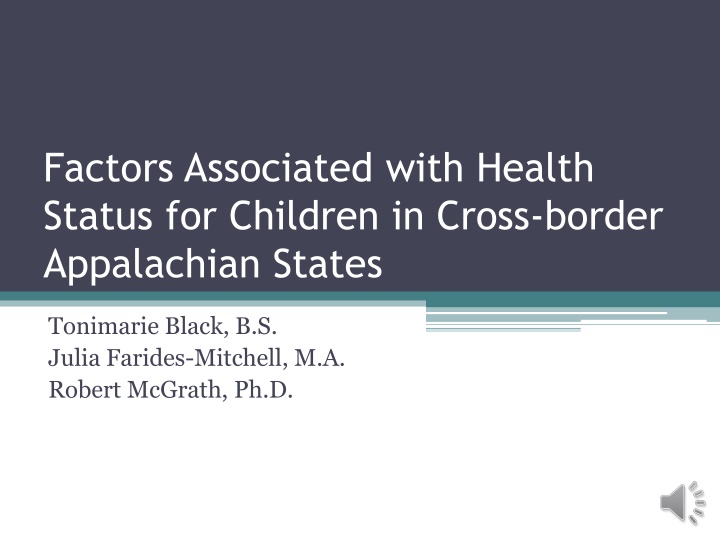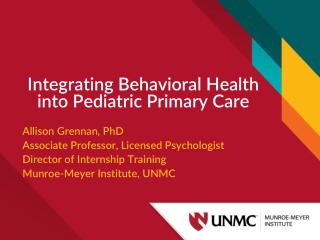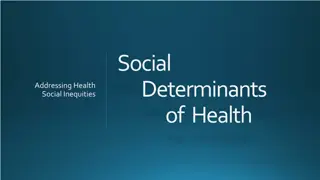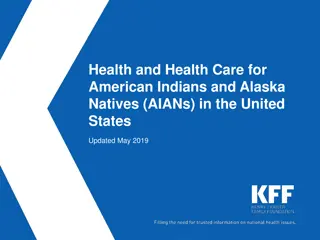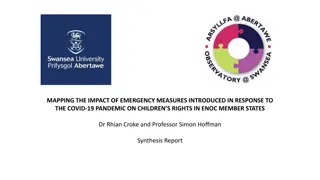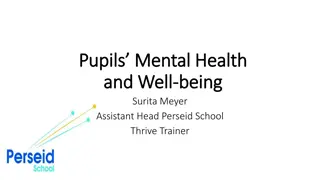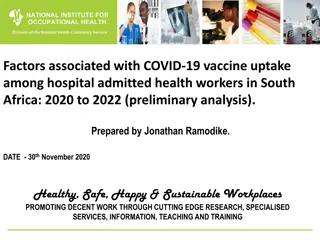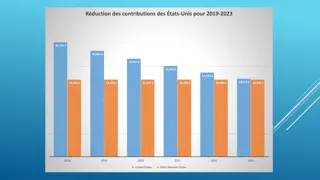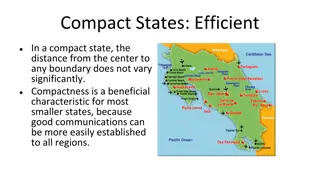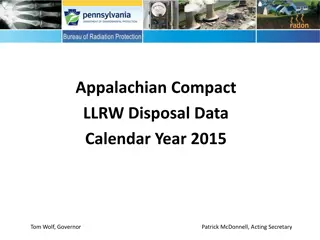Factors Associated with Children's Health in Appalachian States
This study explores factors impacting the health status of children in cross-border Appalachian states, highlighting disparities in healthcare access and the prevalence of health conditions within these communities. The research emphasizes the importance of affordable, safe, and sanitary housing as a fundamental human right in addressing these health issues.
Download Presentation

Please find below an Image/Link to download the presentation.
The content on the website is provided AS IS for your information and personal use only. It may not be sold, licensed, or shared on other websites without obtaining consent from the author.If you encounter any issues during the download, it is possible that the publisher has removed the file from their server.
You are allowed to download the files provided on this website for personal or commercial use, subject to the condition that they are used lawfully. All files are the property of their respective owners.
The content on the website is provided AS IS for your information and personal use only. It may not be sold, licensed, or shared on other websites without obtaining consent from the author.
E N D
Presentation Transcript
Factors Associated with Health Status for Children in Cross-border Appalachian States Tonimarie Black, B.S. Julia Farides-Mitchell, M.A. Robert McGrath, Ph.D.
My Interest Appalachia Service Project (ASP) Works to eradicate substandard housing in the Appalachian region through home repair and restore hope through ministry We accept people right where they are and just the way they are We believe that affordable, safe, sanitary housing is a basic human right.
My Interest Cont. Worked for many different families in Logan County, West Virginia in the summer of 2012 Returned this past summer as a center director in Knott County, Kentucky Research project idea was inspired by ASP and the families I have worked for
Introduction In 2012, the Appalachian Regional Commission commissioned a study to develop the Health Care Costs, Coverage, and Access Index Disparities in access to adequate health care services has been linked to geographic variables Children are often the most vulnerable The study did not look at the health status of children
Quick Facts Virginia Population = 8,260,405 Percent below poverty level = 11.1% Median household income = $63,636 Disability rate = 10.6% Percent of the population on Medicaid = 13%
Quick Facts Cont. West Virginia Population = 1,854,304 Percent below poverty level = 17.6% Median household income = $40,400 Disability rate = 18.8% Percent of the population on Medicaid = 22%
Literature Review Research has shown that individuals in Appalachian communities suffer from a higher number of physical and behavioral health conditions, many manageable with routine care
Literature Review Cont. Authors found that health status could be examined using the Evans and Stoddart social determinants of health framework These domains are: genetic, physical, social, health care system, and individual response
Literature Review Cont. Age, sex, race, parental education, birth weight, health insurance, as well as Medicare and Medicaid, were associated positively with access to healthcare for children thus improving their health status The total number of children without full year healthcare insurance coverage is 20.5 million
The Present Study Hypothesis: Do children in poor primarily Appalachian communities differ in their health status to those in primarily non-Appalachian communities? National Survey of Children s Health 2011 a nationally representative telephone survey that allows for state based estimates Study examines children and adolescents ages 6-17
Measures and Analysis Measures DV: Derived Health Status Health status was derived using questions recoded into additive scales All manageable physical and behavioral conditions were included in the analysis For example: Asthma, diabetes, and depression, as well as their severity responses Variables used were recoded into categories ranging from 0-3 where 3 indicates worse health or more severe condition For variables with more than four possible responses, categories were condensed into four broader categories All analyses were conducted using STATA version 12
Methods and Analysis Cont. Logistic regressions were run on predictor variables against health status Predictor variables were socioeconomic and demographic variables (ex. Income as a % of poverty level, parental education, insurance type etc.) Backwards elimination was used to finalize the model
Sample Statistics 1,256 respondents from VA 1,229 respondents from WV 51% were boys 48% were girls Mean age = 11.7 years
Results: Logistic Regressions West Virginia Health Status No usual place of care Kind of place Usual Provider of care Not covered Delayed or not received care Coef. 95% Confidence Interval 3.499* 0.03077 6.9689 -0.2871 -0.8712 0.297 2.276*** 1.1732 3.3794 -0.1125 -2.1036 1.8786 0.845 -1.6868 3.3769 No physical exam 2.4601* 0.2691 4.6511 Lack of dental care 0.92 -0.6327 2.4728 No vision care Age Race -0.0963 0.06154 1.5837 -1.144 -0.1371 -0.2772 0.9513 0.2602 3.444 No personal doctor -0.0362* -0.0723 -0.0001 Premature Sex 0.1255 -1.756* -1.7316 -3.1399 1.9827 -0.372 Parental education -0.0606 -0.6613 0.5399 Poverty level Insurance type -0.6351*** -0.0379 -0.9158 -0.1032 -0.3543 0.02733 ***p<.001 **p<.01 *p<.05 1075 # of obs
Results: Logistic Regressions Cont. Virginia Health Status No usual place of care Kind of place Usual Provider of care Not covered Delayed or not received care Coef. 95% Confidence Interval 6.5277 -2.092 15.1479 -0.0874 -0.8125 0.6377 0.5014 -0.5649 1.5677 -0.664 -2.1056 0.7775 6.3243** 1.5895 11.0591 No physical exam 2.6052*** 1.6914 3.519 Lack of dental care 1.0181 -1.1788 3.215 No vision care Age Race 0.2214 -0.005 0.194 -0.685 -0.2321 -0.6871 1.1279 0.2219 1.0751 No personal doctor -0.0001 -0.0461 0.0457 Premature Sex 2.0453 -1.617* -1.6678 -2.9826 5.7585 -0.2519 Parental education -0.3751 -1.2521 0.5018 Poverty level Insurance type -0.2854 -0.0508*** -0.6296 -0.0793 0.0588 -0.0222 ***p<.001 **p<.01 *p<.05 1079 # of obs
Findings Children in West Virginia have a higher health burden than children in Virginia Children in West Virginia are not receiving the needed care from a usual provider of care Children in West Virginia have a worse health status when their poverty level is high
Findings Cont. Children in Virginia who do not receive physical exams have worse health status Children in Virginia who have public insurance have worse health than children with no insurance coverage at all
Policy Implications Expansion of Medicaid through the Affordable Care Act cover the gap between current Medicaid eligibility and families being able to afford private health insurance using marketplace subsides West Virginia is expanding Medicaid coverage, whereas Virginia is not expanding Medicaid coverage
Limitations Comparison group is not completely outside of Appalachia Who answered the survey? Appalachian region and access to healthcare has limited research to reference
